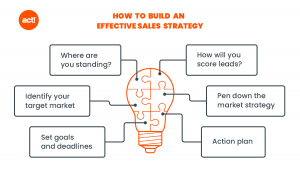
Running a business is much like warfare. You have to be wary of your enemies/competitors, any time you enter the warzone/market. Without a properly laid out war/sales strategy, you will have no chances of coming out of a battle victorious. This means, that unless you plan for every possible risk, and ensure that there are no problem areas within your team, it will be unlikely for you to hit the targets you set out to achieve.
After all, the greatest objective for any sales team is hitting the yearly sales quota. A sales strategy is a master plan that follows extensive market research and corporate introspection and allows a company to keep on selling its products and services effectively. If you do it right, your sales agents will have a field day converting leads into customers and helping your business grow.
Successful businesses reevaluate their sales strategies every month. After having a look at your historic sales, current market conditions, target demographics, and marketing strategies, you devise a monthly sales strategy that will help you attain your goals. Not only does this premeditation equip your sales team with valuable market and customer information, it also allows you to put your finger on any risks, opportunities, or droughts that might pop up soon.
Feeling a bit overwhelmed? Want to create a sales strategy for your business, but don’t know where to start? Fret not, the following list of steps should be enough to help you set up your own sales plan:
Where are you standing?
You know where you want to go, but do you know where you are right now? Before you set out a plan for your business’s future, you need to scrutinize the past and the present to see precisely what you need to change/improve/remove.
An ideal first step is to go over the historic sales statistics. Start by answering questions like:
- Did we attain our sales goals for last year?
- How many leads were converted to customers?
- How much in sales did we make last year?
- Were we able to retain most of our customers? How many customers just bought once?
- Was there a sales pipeline in place?
- What was the longest duration a lead remained within our sales pipeline?
Have a sit-down with all the managers within your company and try to evaluate your business’ position, relevant to the market, before you proceed.

Identify your target market
The importance of targeted marketing in the modern world can’t be stressed enough. To meet your sales quotas and really grow your business, you need to identify the demographics that you want to target. Try to create an ideal customer persona, which you can then base your major business decisions around.
If you have some historic data to dig into, a simple way to identify your target market is by searching for the highest spending customers.
Set goals and deadlines
Every sales strategy defines certain goals that your team then strives to achieve throughout the month/year. It’s better if you quantify these goals; it can be the number of sales, number of customers, number of retained customers, etc. However, when setting goals, make sure you stay realistic. Here are some key points to remember:
- Don’t be over-optimistic: Were you able to achieve last year’s goals? If not, was it because you were being over-optimistic? We all want to grow our business as fast as possible, keeping the sky as the limit, but it’s important
to be realistic too. - Know the market: Some markets can change within seconds, while others maintain their state throughout the year. Know your market before setting goals. If you can foresee a drop in your shares, don’t forecast a sales increase.
- Consult your sales team: Your sales team knows a thing or two about the customers and the market that you don’t. Have a chat with them before you set out goals for them.
Now that your goals are all set, you need to break them down into smaller milestones, and then assign deadlines to these milestones. For example, you want to increase your sales for product B by 50% before the end of the first quarter. The first milestone for this goal could be increasing the sales by 20% before the end of the first month.
How will you score leads?
Your sales agents should be able to prioritize their efforts depending on the quality of the lead. This is why you need to pen down a lead scoring algorithm. How you want to identify a good lead from a bad one depends on your business’ preferences. Want to give a higher score to people from New York? Sure. Want to give a +5 to people who abandoned a cart recently? Up to you!
You can also gradually start discarding (or at least disregarding) the cold leads to ensure that your lead count doesn’t get unnecessarily huge. A marketing automation software can come in handy in this regard by helping you automatically score and track leads.
Pen down the market strategy
The next step involves strategizing your marketing efforts. Answer questions like:
- How can I increase my customer retention?
- How can I up the ante when it comes to word-of-mouth marketing?
- Can I release a new product line for the new demographic I intend to target?
- What are the best channels to gain new leads from?
- Is it financially viable to invest in email marketing automation?
Action plan
It all boils down to this. Now is the time you try to tie everything together and come up with an executable action plan. A sales funnel is an obvious first step. Identify the channels that can maximize lead generation and then create a well-laid path for the leads to funnel through.
At this stage, you can bring the sales team in to talk about the sales funnel. Assign revenue targets to every representative and clear any doubts they have regarding the numbers they need to bring in, and the corresponding deadlines.
Once everyone is on the same page, you can finalize the actionable plans that the entire team can follow. Take as much time as you need as this is the most important piece of the puzzle.
Final word
It takes considerate contemplation to come up with an effective sales strategy, but without it, your business (and your employees) will be directionless. Follow the aforementioned steps and devise your own sales strategy today!






